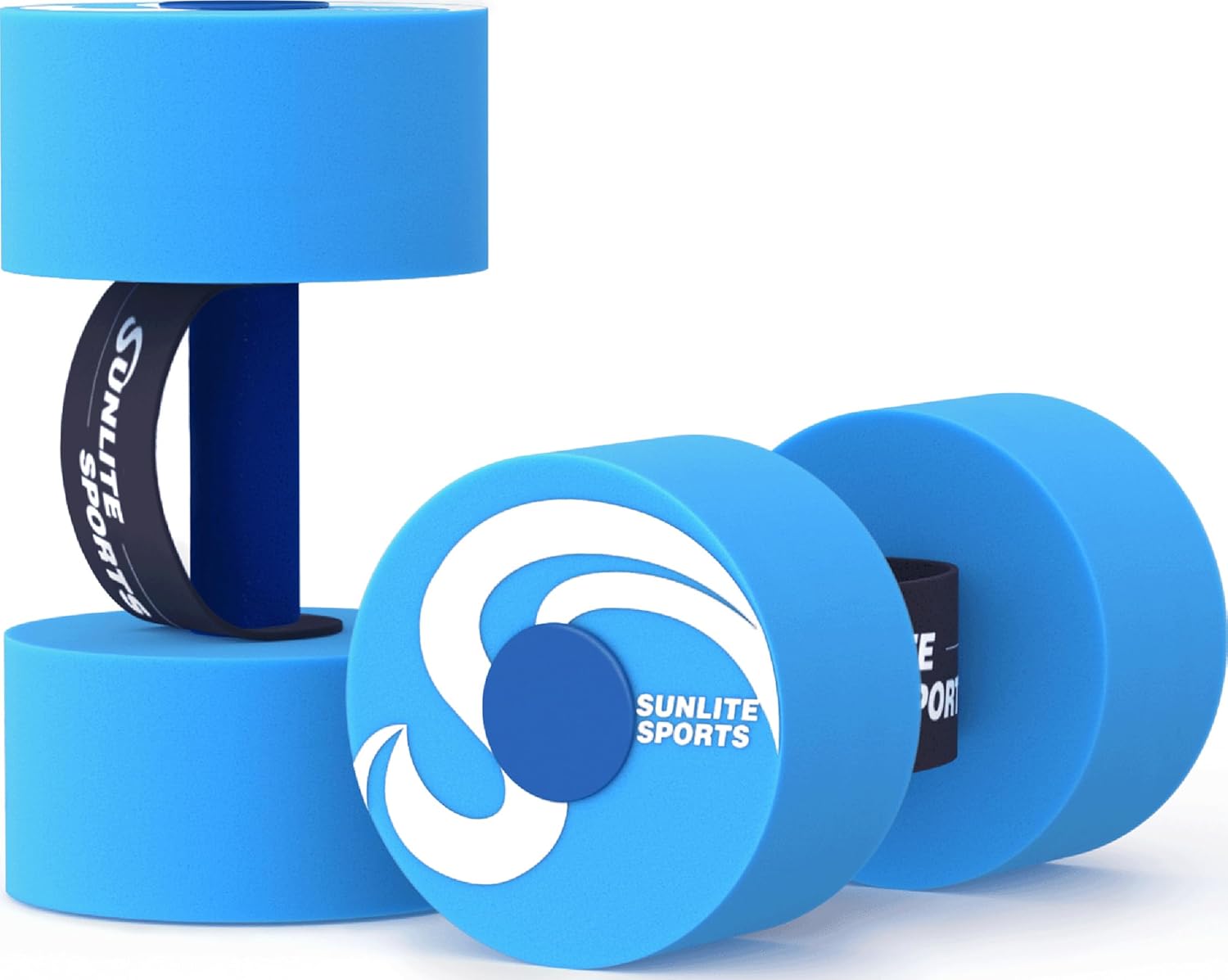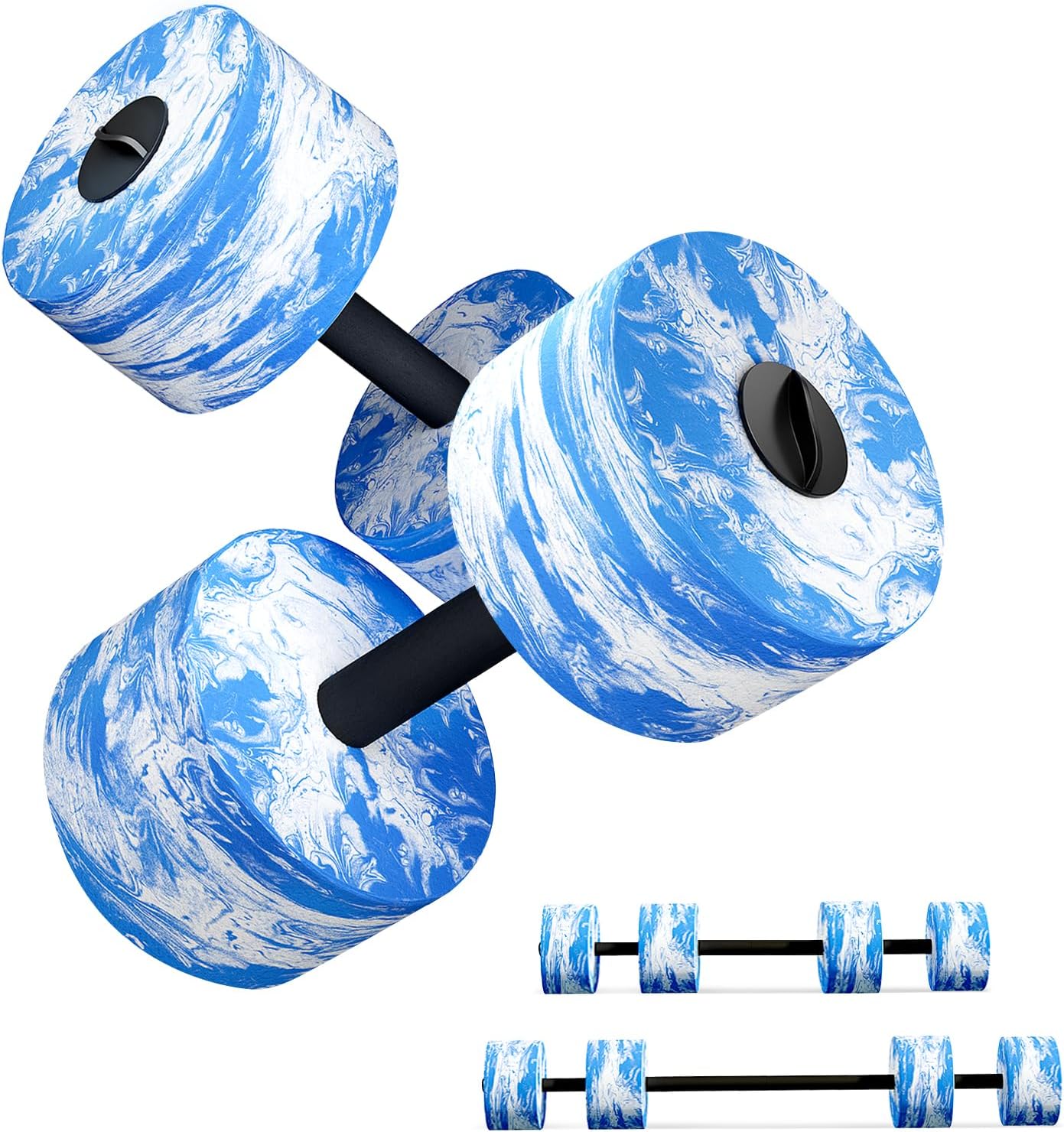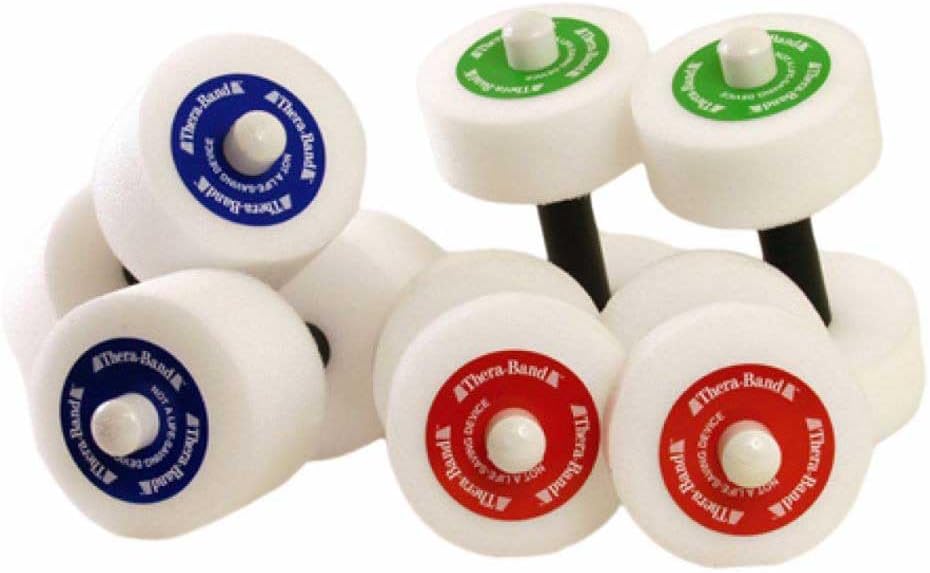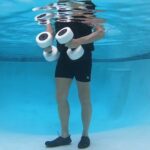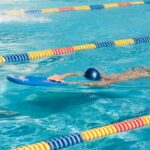How To Exercise With Water Dumbbells
How to exercise with water dumbbells is a question that more people are asking these days, as studies show that water-based resistance training can burn as many calories as traditional weightlifting while being gentler on the joints.
The surprise? Most beginners pick them up thinking they’re just colorful pool toys until their shoulders and core start feeling the burn halfway through a set.
So, before you end up inventing your own awkward splash routine, let’s break it down properly, step by step, so you know exactly how to exercise with water dumbbells for real strength, balance, and cardio results in the water.
How To Exercise With Water Dumbbells?
Water dumbbells are the only weights that fight you without gravity getting involved. It’s like strength training with attitude, but in a pool that doesn’t care about your knees complaining.
Here’s the deal: grab the right water dumbbells, stand in waist-deep water, move slowly against the drag: curl, press, pull, twist. Do 10–15 minutes to start, and build from there. That’s the nutshell answer to how to exercise with water dumbbells. Simple enough, right?
But let’s be honest: you want more than a nutshell. You want the whole coconut. So, let’s go through it properly, step by step, like we’re training partners.
Quick Step-by-Step: How to Exercise with Water Dumbbells
- Choose your gear – Foam water dumbbells are easiest for beginners. Inflatable ones exist, but good foam ones last longer. When people talk about the best water weights for pool exercise, they mean ones with good grip, enough resistance, and durability.
- Get in safe – Waist- to chest-deep water works best. You want enough resistance without losing balance.
- Set your stance – Feet hip-width apart, core lightly braced, shoulders relaxed. Think “tall and steady,” not “tight and tense.”
- Start moving slowly – This is how to use water weights: push, pull, lift, lower. No rushing. Water fights back harder the faster you move.
- Work in reps – 8–12 reps per move – bicep curls, chest presses, lateral raises, triceps kickbacks, rows, and core twists.
- Rest and repeat – One or two sets to start. Add more as you get stronger.
- Cool down – Gentle stretches or slow walking through the water for a minute or two.
Now let’s answer every question you didn’t know you had about exercising with these buoyant troublemakers.
|
|
|
|
Why Workouts with Water Dumbbells Actually Work
Here’s the science in plain talk: water is 800 times denser than air. Push against it, and it pushes back from all directions. That drag creates resistance, so your muscles work through the whole movement instead of just lifting and lowering like on land.
Buoyancy also reduces joint strain. That’s why people with arthritis, knee pain, or balance issues love water workouts. A Mayo Clinic review shows aquatic exercises improve strength and mobility while being easier on joints than traditional gym training.
So, if you’ve wondered how water weights work, it’s not magic, just physics in a swimsuit.
How to Exercise with Water Dumbbells for Beginners
If you’re new to water dumbbells, the first thing to understand is that these aren’t like regular dumbbells made of iron or steel. They’re made from lightweight foam but feel heavy in water because you’re pushing against resistance, not lifting weight.
Start simple:
- Stand in chest-deep water. This keeps you stable and lets your arms move freely.
- Grip the dumbbells correctly. Your palms can face up for curls or down for presses.
- Begin with basic moves. Try bicep curls, front raises, and side raises slowly so you feel the water’s resistance.
- Use steady motions. The faster you push through the water, the more resistance you create, so control matters.
- Start with 10–12 reps per exercise. Two rounds are enough for your first session.
The goal is learning proper form and feeling how water pushes back in all directions. Many beginners make the mistake of rushing through movements or using jerky motions, which reduces effectiveness and strains muscles unnecessarily.
Water Dumbbells Weight Equivalent
People often ask, “How heavy are these things compared to real weights?” The truth is, there’s no direct pound-for-pound equivalent because water resistance depends on:
- Surface area of the dumbbell: Bigger paddles mean more resistance.
- Speed of movement: The faster you move, the heavier it feels.
- Water depth: The deeper you go, the more resistance your arms encounter.
For example, a standard foam dumbbell might feel like lifting 5–8 pounds in water if moved slowly, but pushing it fast can double that resistance. It’s resistance training plus cardio because your muscles and heart work harder at the same time.
Deep Water Exercises with Dumbbells
When you move to deeper water – waist or chest level, you add balance challenges and a core workout. A flotation belt can help you stay stable if you’re not a confident swimmer. Here are a few moves:
- Chest Flys: Float upright, arms out to the side, then bring the dumbbells together in front of you. Great for chest and shoulders.
- Cross-Country Skis: Alternate arms and legs forward and back as if skiing, holding dumbbells for resistance. Builds endurance and coordination.
- Power Pushes: Push the dumbbells straight down into the water fast, then let them float up slowly. Excellent for triceps and shoulders.
Deep water exercises also burn more calories because your body works to stay balanced while moving.
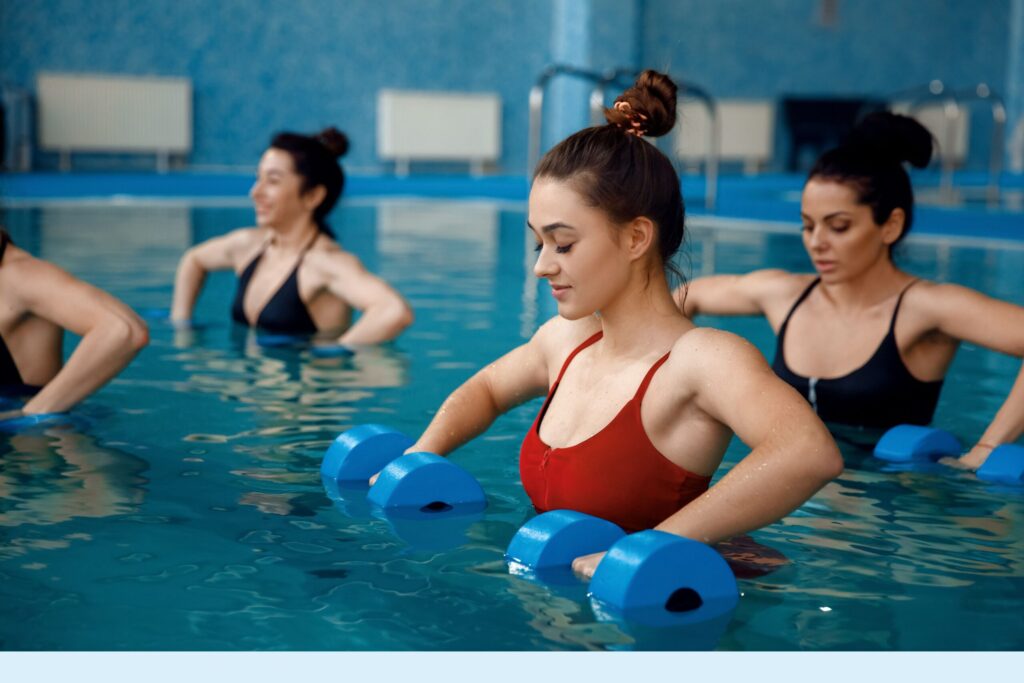
Aqua Exercises with Dumbbells
This includes everything from strength training to cardio routines. A few effective options:
- Water Jogging with Presses: Jog in place while pressing dumbbells overhead. A total-body workout with cardio benefits.
- Squat and Sweep: Squat in waist-deep water while sweeping dumbbells side to side under the surface. Works legs, arms, and core together.
- Figure Eights: Move dumbbells in a horizontal figure-eight pattern under the water to engage shoulders and arms dynamically.
These aqua exercises with dumbbells combine resistance training with swimming pool cardio workouts, making them ideal for people who want strength and endurance without joint strain.
Who Should Use Water Dumbbells and Who Should Be Careful
These workouts are perfect if you:
- Have stiff or achy joints
- Are recovering from certain injuries (with doctor’s OK)
- Want cardio and strength without pounding pavement
- Need low-impact fitness as you age
- Are bored of treadmill life
But check in with your healthcare provider if you have heart conditions, uncontrolled blood pressure, or balance issues in deeper water. Safety beats bravado every time.
Picking the Right Water Dumbbells
When people ask about the best water weights for pool exercise, I tell them to look for three things:
- Material: Closed-cell foam is lightweight, durable, and dries fast.
- Handle grip: Wet hands and slippery plastic are a bad combo. Go for rubber or textured handles.
- Resistance level: Bigger dumbbells catch more water = harder workout. Start small if you’re new.
And yes, rinse them after pool use. Chlorine eats gear for breakfast.
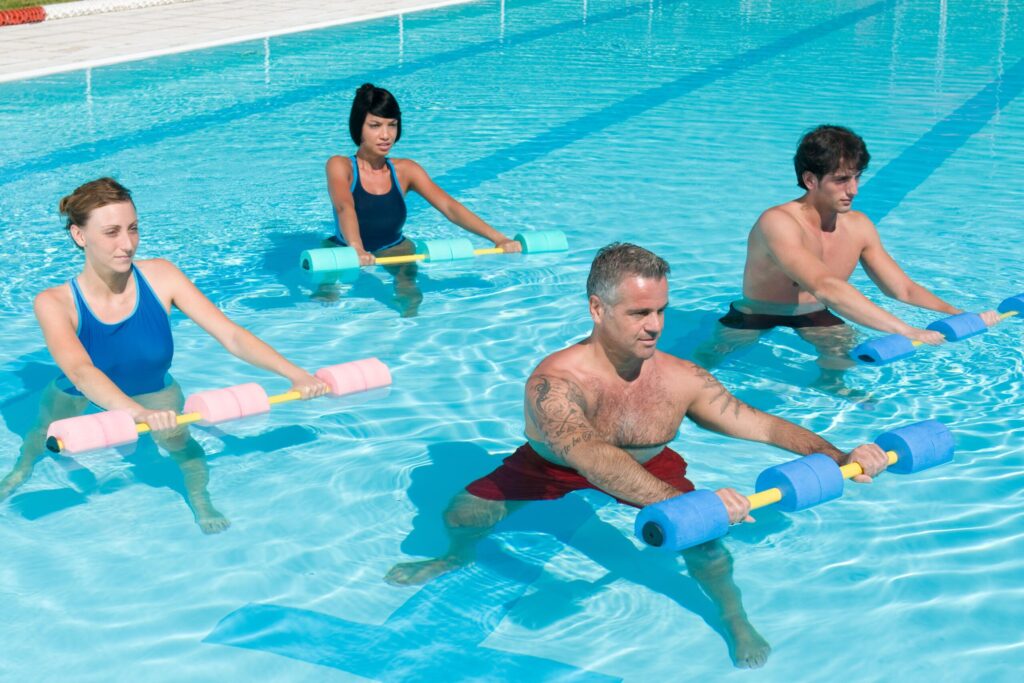
Form Matters: Common Mistakes to Skip
I’ve watched enough people in water aerobics classes to know the top blunders:
- Swinging arms wildly instead of controlled reps
- Standing too deep so they’re tiptoeing instead of grounded
- Shrugging shoulders toward ears while lifting (hello, neck tension)
- Forgetting to breathe
Good form tip: slow, steady, and symmetrical. Count “up for two, down for two” for most moves.
Your First Three Workouts
Beginner Strength Plan
- Warm-up: Walk forward and backward in chest-deep water, 3 min
- Moves (1 set, 8–10 reps each):
- Bicep curls
- Chest presses
- Lateral raises
- Triceps kickbacks
- Core twists
- Cool-down: Arm circles + easy water walking, 2 min
Do this twice a week to start.
Cardio Circuit for Fun
This one leans into pool aerobic exercises and swimming pool cardio workouts.
- One minute each: forward presses, high-knee march, alternating rows, overhead presses, side lunges.
- 30 seconds rest.
- Repeat 3 rounds.
Gets your heart rate up without feeling like running punishment.
Strength + Tone Routine
- Two sets of 10–12 reps each: curls, rows, chest fly, squats with overhead press, standing core twists.
- Increase drag by moving slower or using larger dumbbells as you progress.
How to Progress Without Getting Hurt
Progression rules are simple:
- Add one more set after 2–3 weeks
- Slow your tempo before buying bigger dumbbells
- Add variety: forward, side, rotational moves
- Track how you feel. Slight muscle fatigue is fine; joint pain is not
Realistic Results You Can Expect
You’ll feel stronger, move easier, and burn calories. Studies show water workouts improve functional strength and reduce pain for people with arthritis.
But let’s keep it real: you won’t turn into a bodybuilder with water dumbbells alone. They’re for joint-friendly strength, cardio, and endurance, not maximum muscle size.
Special Tips for Different Needs
- Older adults: Stay in shallower water for stability.
- Pregnancy: Use moderate intensity, no holding breath, keep moves simple.
- Rehab: Follow your therapist’s exercise limits; start with smallest dumbbells.
FAQs on How To Exercise With Water Dumbbells
Can kids use water dumbbells?
Yes, but with supervision and smaller sizes.
How often should I work out?
Two or three sessions a week works for most people.
Do I need to swim?
Nope. These workouts happen in waist- to chest-deep water.
How do I clean them?
Rinse, air dry, store out of direct sun.
The Bottom Line on How To Exercise With Water Dumbbells
So now you know exactly how to exercise with water dumbbells:
- Choose the right gear
- Learn the basic moves
- Start with short, slow sets
- Build strength or cardio depending on your goal
- Progress safely over time
You’ve got beginner workouts, cardio options, strength plans, and answers to every “what if” people usually ask. And along the way, you’ve learned how to use water weights properly, why they work, and what makes them effective.
Your pool just became a gym with better lighting, lower impact, and a built-in cool-down system.
